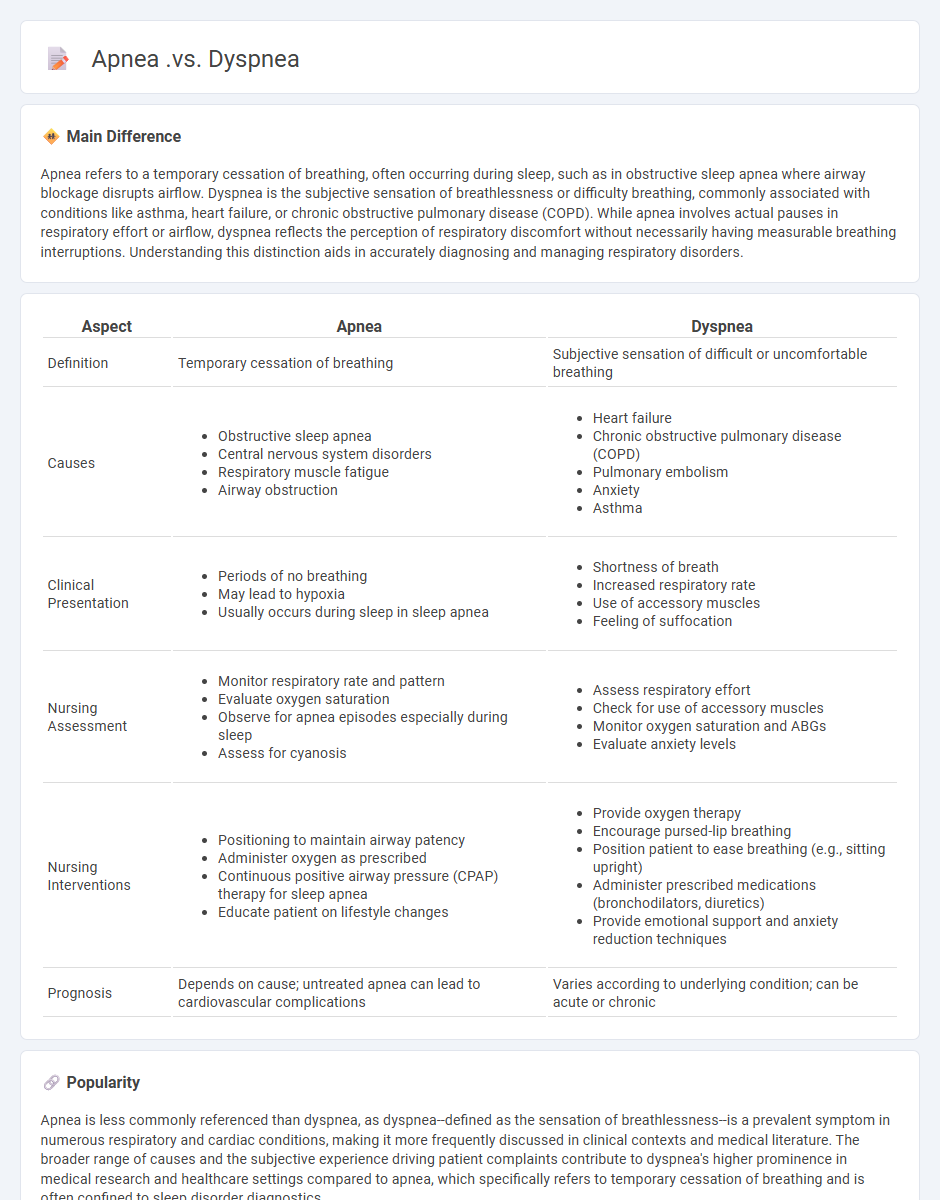
Apnea refers to a temporary cessation of breathing, often occurring during sleep, while dyspnea is the sensation of difficult or labored breathing experienced during activity or at rest. Understanding the distinct causes and symptoms of apnea and dyspnea is crucial for accurate diagnosis and effective treatment in respiratory medicine. Explore further to learn about diagnostic methods and therapeutic options for these breathing disorders.
Main Difference
Apnea refers to a temporary cessation of breathing, often occurring during sleep, such as in obstructive sleep apnea where airway blockage disrupts airflow. Dyspnea is the subjective sensation of breathlessness or difficulty breathing, commonly associated with conditions like asthma, heart failure, or chronic obstructive pulmonary disease (COPD). While apnea involves actual pauses in respiratory effort or airflow, dyspnea reflects the perception of respiratory discomfort without necessarily having measurable breathing interruptions. Understanding this distinction aids in accurately diagnosing and managing respiratory disorders.
Connection
Apnea and dyspnea are interconnected respiratory conditions impacting breathing patterns. Apnea involves temporary cessation of breathing, often during sleep, while dyspnea refers to the subjective sensation of breathlessness or difficulty breathing. Both symptoms can indicate underlying disorders such as obstructive sleep apnea, chronic obstructive pulmonary disease, or heart failure, highlighting their clinical significance in respiratory and cardiovascular assessments.
Comparison Table
| Aspect | Apnea | Dyspnea |
|---|---|---|
| Definition | Temporary cessation of breathing | Subjective sensation of difficult or uncomfortable breathing |
| Causes |
|
|
| Clinical Presentation |
|
|
| Nursing Assessment |
|
|
| Nursing Interventions |
|
|
| Prognosis | Depends on cause; untreated apnea can lead to cardiovascular complications | Varies according to underlying condition; can be acute or chronic |
Apnea
Apnea, characterized by temporary cessation of breathing, is a critical condition monitored closely in nursing care to prevent hypoxia and respiratory failure. Nurses perform continuous respiratory assessments and use pulse oximetry to detect early signs of apnea in patients, especially those with sleep apnea or post-operative complications. Treatment protocols often include positioning, administering oxygen therapy, and coordinating with respiratory therapists for advanced interventions like CPAP. Accurate documentation and patient education on apnea management are essential to improving outcomes and reducing hospital readmissions.
Dyspnea
Dyspnea, commonly experienced by patients in nursing care, refers to the subjective sensation of breathing discomfort characterized by varying intensities of shortness of breath. Effective nursing management involves continuous assessment of respiratory rate, oxygen saturation levels, and the use of dyspnea scales such as the Modified Borg Scale to quantify patient distress. Interventions include positioning to optimize ventilation, administering prescribed oxygen therapy, and monitoring for underlying causes like heart failure or chronic obstructive pulmonary disease (COPD). Documentation of response to treatment and timely communication with interdisciplinary teams is essential for improving patient outcomes.
Respiratory Assessment
Respiratory assessment in nursing involves evaluating a patient's ventilation, oxygenation, and airway status through techniques such as inspection, palpation, percussion, and auscultation. Key indicators include respiratory rate, rhythm, depth, presence of breath sounds, and use of accessory muscles. Nurses collect data on oxygen saturation levels using pulse oximetry and assess for symptoms like dyspnea, cough, or cyanosis. Accurate respiratory assessments support early detection of conditions such as pneumonia, chronic obstructive pulmonary disease (COPD), and asthma exacerbations.
Clinical Manifestations
Clinical manifestations in nursing refer to the observable signs and symptoms that indicate a patient's health condition or disease state. These manifestations guide nurses in assessment, diagnosis, and the development of individualized care plans. Common examples include fever, pain, edema, and changes in vital signs, which provide crucial information for monitoring patient progress. Accurate documentation and interpretation of clinical manifestations improve patient outcomes through timely interventions and effective communication among healthcare teams.
Nursing Interventions
Nursing interventions encompass a wide range of actions designed to promote patient health, prevent illness, and facilitate recovery through evidence-based practices. These interventions include monitoring vital signs, administering medications accurately, providing wound care, and educating patients about their treatment plans. Effective documentation and communication among healthcare teams ensure continuity of care and improve patient outcomes. Research shows that tailored nursing interventions can significantly reduce hospital readmission rates and enhance quality of life for chronic disease patients.
Source and External Links
Difference Between Apnea and Dyspnea - Apnea is the complete cessation of breathing for 10 seconds or more, usually during sleep, while dyspnea is the uncomfortable feeling of needing to breathe without full obstruction.
Dyspnea (Shortness of Breath): Causes, Symptoms & Treatment - Dyspnea is a feeling of not getting enough air, which can be acute or chronic, caused by various conditions such as heart or lung diseases, anxiety, or exercise.
Understanding Paroxysmal Nocturnal Dyspnea | SleepApnea.org - Sleep apnea involves repeated stoppages of breathing during sleep, whereas paroxysmal nocturnal dyspnea is a sudden shortness of breath that wakes a person, showing that apnea is a full stop in breathing, dyspnea is a distressing sensation of breathlessness.
FAQs
What is apnea?
Apnea is a temporary cessation of breathing, often occurring during sleep, commonly known as sleep apnea.
What is dyspnea?
Dyspnea is the medical term for shortness of breath or difficulty breathing.
How do the symptoms of apnea and dyspnea differ?
Apnea is characterized by temporary cessation of breathing, while dyspnea involves difficulty or labored breathing with a sensation of shortness of breath.
What causes apnea?
Apnea is caused by airway obstruction, neurological disorders, obesity, and respiratory muscle weakness.
What are the common causes of dyspnea?
Common causes of dyspnea include chronic obstructive pulmonary disease (COPD), asthma, heart failure, pneumonia, pulmonary embolism, anemia, and anxiety disorders.
How are apnea and dyspnea diagnosed?
Apnea is diagnosed primarily through polysomnography (sleep study) measuring breathing interruptions during sleep; dyspnea is diagnosed by clinical evaluation, spirometry, arterial blood gases, and imaging tests to assess underlying respiratory or cardiac conditions.
What are the treatments for apnea and dyspnea?
Continuous positive airway pressure (CPAP) therapy and lifestyle changes effectively treat apnea; oxygen therapy, bronchodilators, corticosteroids, and mechanical ventilation address dyspnea depending on the underlying cause.
 calledges.com
calledges.com